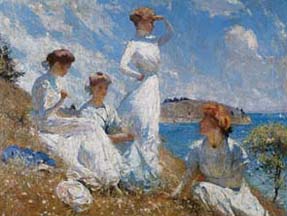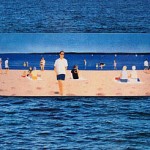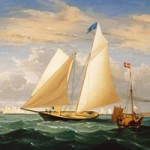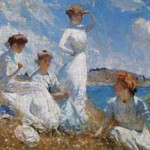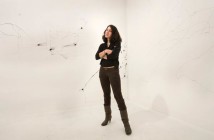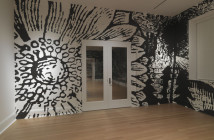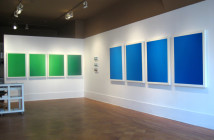I went to see Katz. Honestly, I really did. The single, self-serving reason I drove to the Peabody Essex Museum, in Salem, MA, was to see a panoramic painting by the artist Alex Katz. I don’t know what else to say, I just really dig this guy’s paintings. As for the importance of Katz as an artist today, I have one word to define it: consistency. Alex Katz has managed to sustain a 51 year career in an industry that suffers from a textbook case of ADHD. Without Katz’s exploration into portraiture the art world would have never been fertile ground for artists such as George Condo, Dana Schutz, and Boston’s own Don Hartmann.
The painting I went to see was Harbor #9, oil on canvas, dated 1999. It is 96 inches tall and 240 inches wide. The idea that Katz’s process led him to paint 9 of these harbor paintings, as the title suggests, was enough to make me pause and wonder about the artist’s state of mind. What couldn’t Katz say in the first painting that he could in #9, which is just one of more than 100 works by 82 artists currently on view at the Peabody Essex Museum’s exhibition entitled Painting Summer in New England (PSNE).
You have to give a round of applause to the guest curator, Trevor Fairbrother, for the way in which he handles not only the scale of the exhibition, but also the content. The placement of two paintings in particular brought to my attention this curator’s understanding of how to connect paintings. The two pieces in question are stylistically a hundred years apart, but hang side by side. James Edward Butterworth’s painting is “Yacht Race off Boston Light”, dated 1880 and Paul Resika’s The End of the Hurricane, is from 1979. Butterworth’s Yacht Race off Boston Light is a realistically painted maritime narrative with a schooner cutting through a deep green ocean, while Resika’s The End of the Hurricane is an expressive gestural painting that depicts the moment when the sky releases all the built up tension after a hurricane. Both paintings have a loosely similar palette and a proportionate relation in physical size. A viewer might make the connection that both of these paintings, although representing different styles, are speaking about a specific moment in time. An astute viewer, however, would realize that Fairbrother also chose to be involved; the curator consciously places these two paintings next to one another, becoming an active participant in the continuation of the theme of time.
PSNE is laid out over five separate galleries encompassing the entire third floor of the museum. When you think that you’re at the end of the show, there seems to always be one more gallery just ahead of you. At this point I need to openly admit to a long-standing suspicion, it’s what I like to call “The Big Name Museum Show Syndrome”. It’s when a museum designs an exhibition around a few works of art by a famous or almost famous artist that, coincidentally, my mother would like.
I’ll go as far as to argue that the traditional role of a museum as a steward of culture, a place where artifacts are stored, has been replaced with the idea that a museum is now in the position of one that defines culture, confirming the idea that fine art is truly elitist, all the way to the bank. Much to my surprise, the gift shop is located nowhere near any of the galleries at the Peabody Essex Museum. If the exhibition you’re viewing – with or without the assistance of an audio device, its sole purpose being to guide the viewer – ends at the front door of the Museum’s gift shop, you should be suspicious. (In that circumstance I try, whenever possible, to see the show in reverse.)
Links:
Peabody Essex Museum
Alex Katz Harbor #9 magnet at the PEM giftshop
"Painting Summer in New England" is on view until September 4th at the Peabody Essex Museum, located at East India Square in Salem, MA.
All images are courtesy of PEM and their representive venues.

